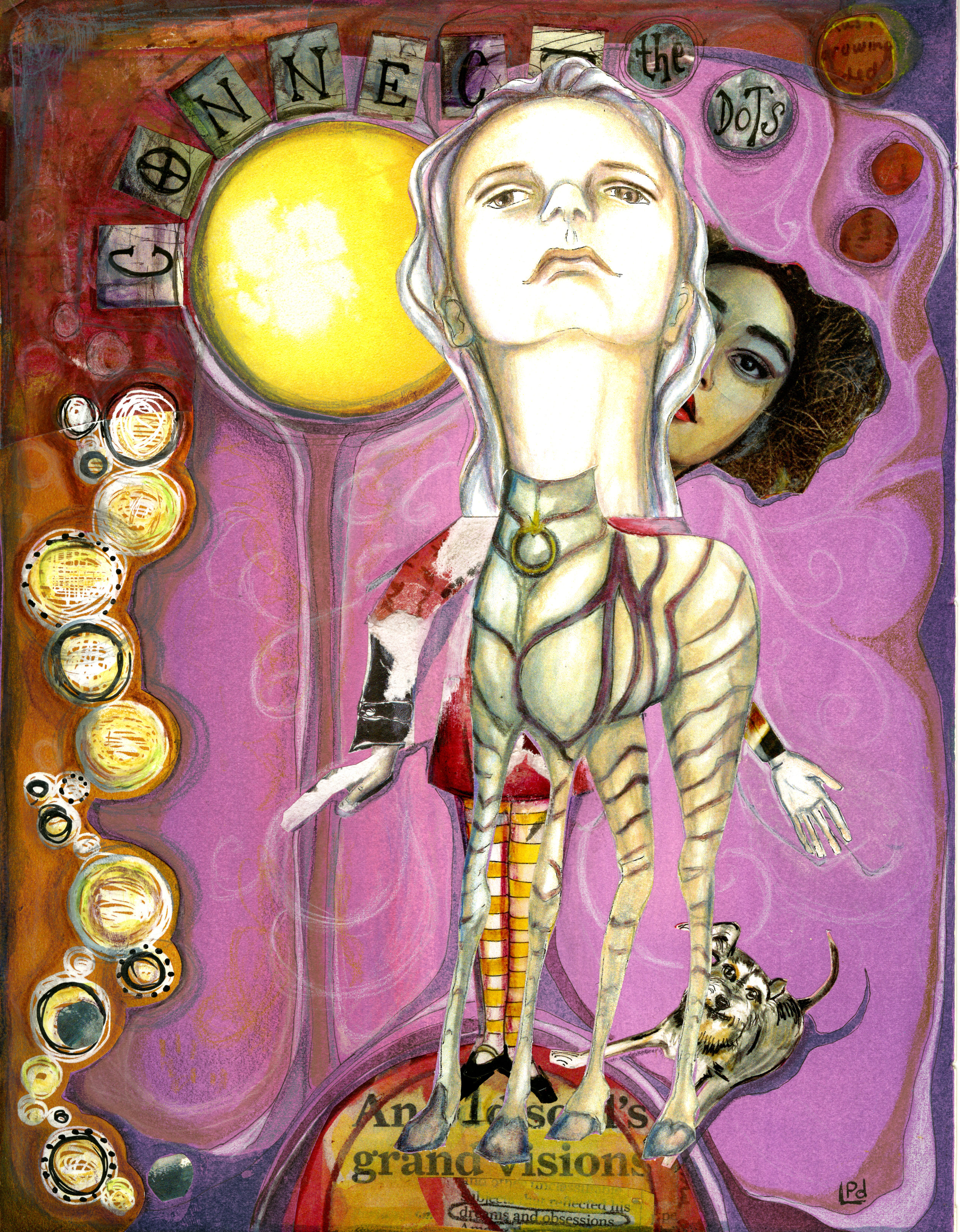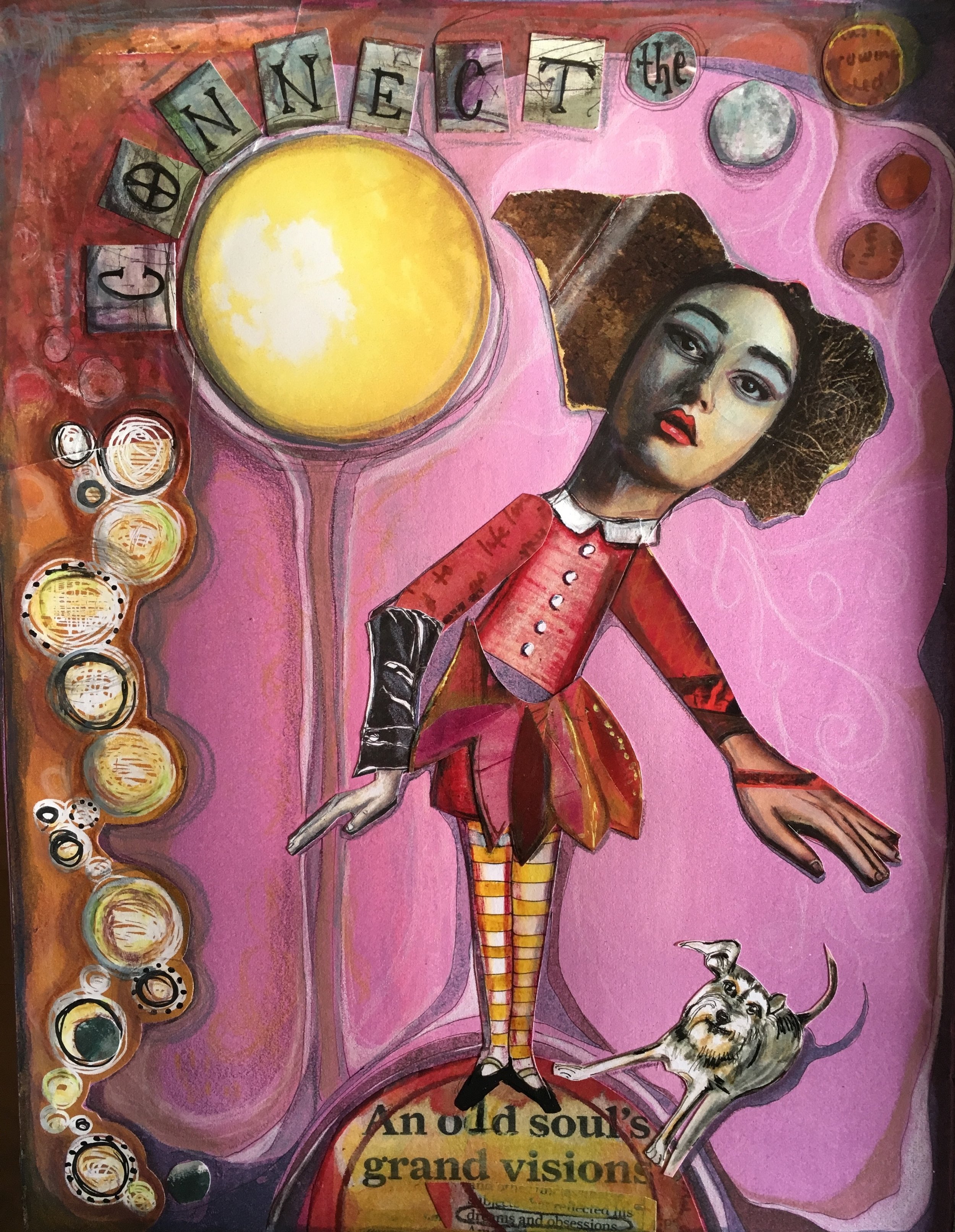In With the New
I was sitting cross-legged on the floor pulling pieces of artwork from my journals. I had been invited to participate in a local art show, and each time I came upon something I thought might work, I tossed in onto our dining room table for consideration. As I made my way through the piles, a figure I made years earlier, a woman’s face on a zebra’s body (a she-bra?) fell out of one of my notebooks. Standing solidly on four legs, chin raised defiantly in the air, it was an image I always felt exuded confidence and strength. I had tried to use it in various collages before, but it never quite fit, so it ended up, time and again, back in a drawer. Frustrated that I hadn’t yet found it a home, I threw it too onto the table, and went to have lunch, thinking about how odd it was that my work would soon be hanging in a public space. It had been about three decades since that last happened.
I had been an artist during my teens, and a fairly decent one at that. I was even accepted into a prestigious art school, but transferred out shortly after completing my first year. I had no choice. While I had managed to do what was necessary to finish the year successfully, the thought of drawing and painting was suddenly so unappealing; I literally could not force myself to do it any longer. That is not to say I no longer loved art. I adored art, and incorporated it into my life whenever possible. I transferred to a university and got my undergraduate degree in art history before moving on to a career in business. I enrolled our children in a Jewish preschool, (despite not being Jewish) in large part because of the outstanding art enrichment program the school had developed. I made elaborate Halloween costumes every year, and volunteered to help during art classes in our local elementary and middle schools. I was constantly buying our children pads of beautiful paper, rainbows of colored pencils, markers galore. They could identify Van Gogh’s Starry Night as easily as Santa Claus before they entered kindergarten. But I did not draw. I did not paint. Not one thing. Not for more than 25 years. And I really couldn’t figure out why.
Sure I would have liked to be making art. I did miss it. But, it was okay. I had a lot of other wonderful things in my life. Things were going well. And then suddenly, they weren’t. First one uncle died, then another, then a close family friend, my grandmother, another uncle. All within a relatively short period of time. I come from a close-knit family. It was too much. There were no words. Suddenly I was overwhelmed with a need to make art, while at the same time paralyzed by my inability to do so. In searching for a place to take basic art lessons, I came upon an ad for a collage class. No drawing necessary. This seemed more my speed. Surely I could cut and paste? I signed up.
A Shadow Artist is someone who deep down has the desire to be an artist, but due to various reasons (lack of support, negative beliefs they hold regarding making art, fear, not believing one’s work is good enough, etc., etc., etc.) instead chooses a different path. Because of their true feelings however, they often find other, more “acceptable” ways to stay close to the arts. The want-to be-author may work in publishing for example, instead of writing a novel himself. A doctor, who would much rather be a painter, may become a benefactor at her favorite museum.
When I first read about Shadow Artists in Julia Cameron’s book, The Artist’s Way, I was startled by the feelings of recognition it stirred up. It was as though someone had gained access to my soul and brought to the surface something I had been hiding, but until that moment, had not even realized existed. The emotions were uncomfortable so I put the book away; happy to go back to making collages I had no intention of displaying, and allowing only a handful of people I deemed “safe” to see them.
But it’s hard to un-know something once it has shown itself to you, and the more I tried to ignore the Shadow Artist, the more desperate she became to be seen. She showed her face first in one of my collages, and the experience filled me with such sadness, I found myself crying while trying to finish it. My tears seemed only to up her resolve, as she kept pushing pencils and paintbrushes relentlessly into my hand. Eventually it became easier to acknowledge her than to keep denying her existence. I started cautiously drawing and painting, despite the fact that I still had trouble referring to myself as an artist. It took awhile, but in time I started to feel its joy again, and more comfortable sharing what it is I do, and when the Shadow Artist showed up uninvited yet again in another collage, she no longer invoked grief, but instead seemed to be presenting herself as a challenge. I named that collage “Connect the Dots,” a reference to what I was discovering about myself.
That very piece was now lying on my dining room table, and as I walked back in after lunch to finish choosing pieces for the show, I saw that the strong, confident image I had had so much trouble placing before, had landed on top of it in such a way that the Shadow Artist was almost completely covered. She had finally found her rightful home. I immediately sat down and started to peel the Shadow Artist off the page, stopping (and patching her up a bit) only when I realized I didn’t need her to be gone completely, only gently held back.
In case you are wondering why I gave up on making art in the first place, I think I have it (mostly) figured out: Art school is a wonderful choice for many people, but it didn’t work for me, because it didn’t match the way I create, or how I feel about my purpose as an artist. For me, the process, and what it reveals, is just as important (maybe even more so), than the finished product. I might polish things up at the end so it looks a little better, but the inspiration cannot be prescribed. If I am given too many specifics about what to make, how to make it, or even what materials must be used, I stumble, getting caught up in perfectionistic thoughts and worries about meeting others’ expectations of how art should look. I work best when I just sit down and see what happens. Art as an “assignment” (essentially what my first year of art school was all about) drained me, leaving me with nothing left to give.
Art as “competition” (being compared and graded against my fellow students) had an even more negative effect. People who know me well may find this funny, as I do have quite a competitive streak in other areas, but it is not the way I view the arts. I see them as a medium for bringing people together through connection and community, shared ideas, thoughts, feelings and culture. For me, they just don’t work as a zero-sum game.

